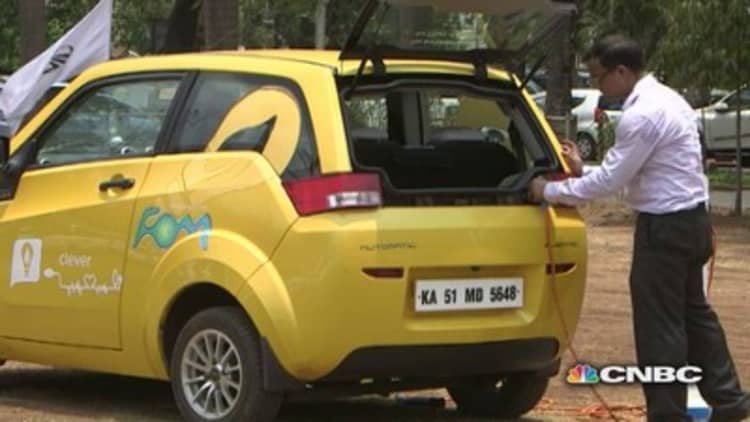
With over one billion cars on roads throughout the world, coping with clogged, smog filled streets is a problem many of us will be familiar with. Could vehicles powered by lithium ion batteries and solar power hold the key to greener, cleaner streets?
For years, electric cars have been championed as a panacea to urban air pollution. Electric vehicle company Mahindra Reva – part of the Mahindra Group, the Mumbai based global conglomerate – launched the e2o last year. Fully electric and with a range of 100km when charged, it is described by the company as 'the future of mobility'.
Read MoreBuilding the 'smarter' home
"The thinking behind it from the Mahindra Group point of view is very simple: we believe that gasoline and diesel will not remain fuels of choice forever," Dr Pawan Goenka, Mahindra's Executive Director & President, Automotive, Farm Equipment and Two Wheeler Sectors, told CNBC.com in a phone interview.
"Alternate fuels will come in, though it's taken much longer than what most people thought ten, twenty years ago," Goenka added. "Twenty years ago, a lot of people thought that by now a fairly large percentage of vehicles sold would be non-conventional energy vehicles. That has not happened but we do believe it will, sooner or later."
It is within this context that the e2o was developed and brought to market. "We have put in a lot of… very interesting technology into the vehicle," Goenka said. "If you walk out without locking the car, you get a text message saying you haven't locked your car."
Read MoreSolar: Is this how to solve the energy problem?
Other features include the ability to switch air conditioning on and off using a smartphone and REVive, a patented technology that reserves energy for users in case they run out of power while on the road. "If you suddenly get stuck and send a text message, we'll release that charge for you so you'll have 8km to go before you run out of charge," Goenka added.
While the e2o may be packed full of high tech features, uptake of the car in India has, so far, been small. According to Goenka, however, it's a matter of when, not if.
"Not selling enough is not a permanent phenomenon, it's a temporary phenomenon," he said. "The government of India has a very ambitious plan for supporting electric and hybrid vehicle development," he added.
Could though, the future of cars be solar, as well as electric? At the Eindhoven University of Technology, Solar Team Eindhoven – made up of students from the university – have developed Stella, a four seater family car covered in 'high-yield silicum solar panels' and powered by the sun.
"With a solar car, you don't have to feed it anything, it's using the sun, which is a durable source in itself," Roy Cobbenhagen, Solar Team Eindhoven's technical director, told CNBC.com in a phone interview. "Solar panels are increasing in efficiency and dropping in cost very rapidly… imagine what could happen in ten years," he added.
Weighing just 390kg and with a sleek, aerodynamic design, Stella has a range of 780km – 484 miles – when fully charged on a sunny day, and 430km at night.
In 2013, the car won the cruiser class category of the World Solar Challenge, a 3,000km journey across Australia, with Stella reaching a top speed of 120km/h at some stages.
Read More10 innovations that changed the world
Solar Team Eindhoven's ambitions stretch further than winning the challenge, however. "Stella was a prototype, it's one of a kind, but mass manufacturing Stella or similar solar cars? That could be possible in ten years," Cobbenhagen said.
Could then, the family car of the future be modeled on Stella? "That is our dream, and that's also what I truly believe," Cobbenhagen said. "Who doesn't want to drive for free?"
Follow us on Twitter: @CNBCWorld

